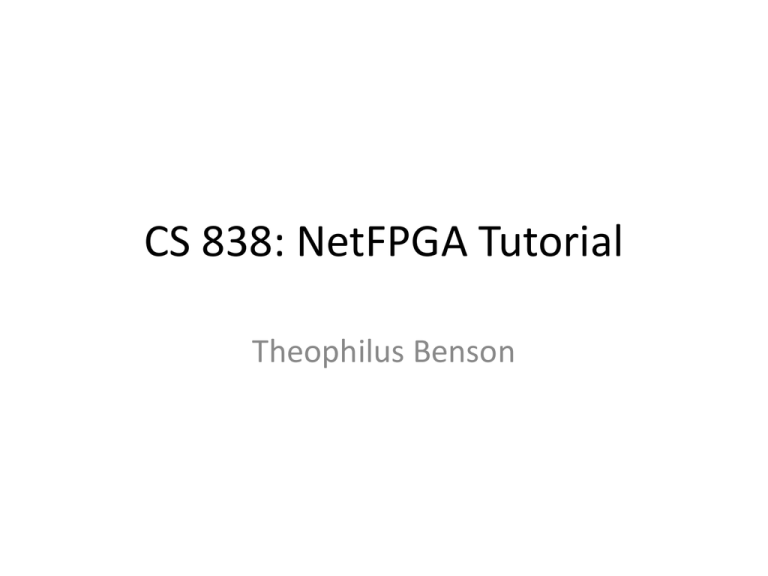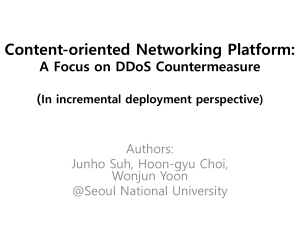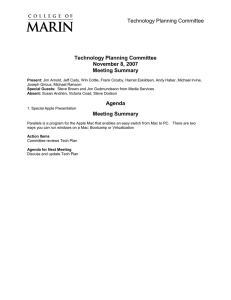CS 838: NetFPGA Tutorial Theophilus Benson
advertisement

CS 838: NetFPGA Tutorial
Theophilus Benson
Outline
• Background: What is the NetFPGA?
• Life cycle of a packet through a NetFPGA
• Demo
What is the NetFPGA?
Networking
Software
running on a
standard PC
CPU
Memory
PCI
A hardware
accelerator
built with Field
Programmable
Gate Array
driving Gigabit
network links
1GE
FPGA
1GE
1GE
Memory
1GE
NetFPGA Router
Function
– 4 Gigabit Ethernet ports
Fully programmable
– FPGA hardware
Open-source FPGA hardware -– Verilog base design
Open-source Software -- Linux user Level
– Drivers in C and C++
NetFPGA Platform
Major Components
– Interfaces
• 4 Gigabit Ethernet Ports
• PCI Host Interface
– Memories
• 36Mbits Static RAM
• 512Mbits DDR2 Dynamic RAM
– FPGA Resources
• Block RAMs
• Configurable Logic Block (CLBs)
• Memory Mapped Registers
NetFGPA: Router Design
• Pipeline of modules
– FIFO queues between each module
• Inter module communication
– CTRL: Send on ctrl bus (8 bits)
• Metadata about the data being send
– DATA: Send on data bus (64 bits)
– RDY: Signifies ready to receive packet (1 bit)
– WR: Signifies packet being send(1bit)
NetFPGA
FGPA
Modules 2
Hardware
FGPA
Modules 1
Software
Linux
Processes
Linux user-level
processes
Verilog on
NetFPGA PCI board
Example: An IP Router on NetFPGA
Exception
Processing
Switching
Hardware
Forwarding
Table
Routing
Protocols
Routing
Table
Software
Management
& CLI
Linux user-level
processes
Verilog on
NetFPGA PCI board
Life of a Packet through the hardware
192.168.10
1.x
port0
port2
192.168.10
2.y
Router Stages
MAC
RxQ
CPU
RxQ
MAC
RxQ
CPU
RxQ
MAC
RxQ
CPU
RxQ
MAC
RxQ
CPU
RxQ
Input Arbiter
Output Port Lookup
Output Queues
MAC
TxQ
CPU
TxQ
MAC
TxQ
CPU
TxQ
MAC
TxQ
CPU
TxQ
MAC
TxQ
CPU
TxQ
Inter-module Communication
Using “Module Headers”:
Ctrl Word
(8 bits)
Data Word
(64 bits)
x
Module Hdr
…
…
y
Last Module Hdr
0
Eth Hdr
0
IP Hdr
0
0x10
…
Last word of packet
Contain information
such as packet length,
input port, output port,
…
Inter-module Communication
data
ctrl
wr
rdy
MAC Rx Queue
Rx Queue
0xff
0
0
0
Pkt length,
input port = 0
Eth Hdr:
Dst MAC = port 0,
Ethertype = IP
IP Hdr:
IP Dst: 192.168.2.3, TTL:
64, Csum:0x3ab4
Data
Input Arbiter
Pkt
Pkt
Pkt
Output Port Lookup
1- Check input
port matches Dst
MAC
Output Port Lookup
0x04
2- Check TTL,
checksum
3- Lookup next
hop IP & output
port (LPM)
0xff
0
0
4- Lookup next
hop MAC
address (ARP)
0
5- Add output
port module
output port = 4
Pkt length,
input port = 0
EthHdr:
MAC
=0
EthHdr:
Dst Dst
MAC
= nextHop
MAC
= x, 4,
SrcSrc
MAC
= port
Ethertype = IP
IP Hdr:
IP Dst: 192.168.2.3, TTL:
64,
63, Csum:0x3ab4
Csum:0x3ac2
Data
6- Modify MAC
Dst and Src
addresses
7-Decrement TTL
and update
checksum
Output Queues
OQ0
OQ4
OQ7
MAC Tx Queue
MAC Tx Queue
0x04
0xff
0
0
0
output port = 4
Pkt length,
input port = 0
EthHdr: Dst MAC = nextHop
Src MAC = port 4,
Ethertype = IP
IP Hdr:
IP Dst: 192.168.2.3, TTL:
64,
63, Csum:0x3ab4
Csum:0x3ac2
Data
NetFPGA-Host Interaction
• Linux driver interfaces with hardware
– Packet interface via standard Linux network stack
– Register reads/writes via ioctl system call (with
convenience wrapper functions)
• readReg(nf2device *dev, int address, unsigned *rd_data)
• writeReg(nf2device *dev, int address, unsigned *wr_data)
eg:
readReg(&nf2, OQ_NUM_PKTS_STORED_0, &val);
NetFPGA-Host
Interaction
Register access
PCI Bus
1. Software makes ioctl call on
network socket. ioctl passed to
driver.
2. Driver
performs PCI
memory
read/write
NetFPGA-Host Interaction
• Packet transfers shown using DMA interface
• Alternative: use programmed IO to transfer
packets via register reads/writes
– slower but eliminates the need to deal with
network sockets
DEMO: Life of a Packet through the
hardware
192.168.1.x
port0
port2
192.168.2.y
• Programming the FPGA with your code
– nf2_download NF2/bitfiles/reference_router.bit
• Mirror linux arp
– ./NF2/projects/router_kit/sw/rkd
• Helpful tool
– ./NFlib/C/router/cli
– Shows forwarding tables {arp table, ip table}
– Allows to modify tables
Useful Links
•
•
•
•
•
NetFPGA Website
NetFPGA Wiki
NetFPGA Guide
Walkthrough the Reference Designs
The Verilog Golden Reference Guide
Questions
Verilog
Hardware
• Concurrent
Description Languages
– By Default, Verilog statements
evaluated concurrently
• Express fine grain parallelism
– Allows gate-level parallelism
• Provides Precise Description
– Eliminates ambiguity about operation
• Synthesizable
– Generates hardware from description
Verilog Data Types
reg [7:0] A; // 8-bit register, MSB to LSB
// (Preferred bit order for NetFPGA)
reg [0:15] B; // 16-bit register, LSB to MSB
B = {A[7:0],A[0:7]}; // Assignment of bits
reg [31:0] Mem [0:1023]; // 1K Word Memory
integer Count; // simple signed 32-bit integer
integer K[1:64]; // an array of 64 integers
time Start, Stop; // Two 64-bit time variables
From: CSCI 320 Computer Architecture
Handbook on Verilog HDL, by Dr. Daniel C. Hyde :
http://eesun.free.fr/DOC/VERILOG/verilog-manual.html
Signal Multiplexers
Two input multiplexer (using if / else)
reg y;
always @*
if (select)
y = a;
else
y = b;
Two input multiplexer (using ternary operator ?:)
wire t = (select ? a : b);
From: http://eesun.free.fr/DOC/VERILOG/synvlg.html
Larger Multiplexers
Three input multiplexer
reg s;
always @*
begin
case (select2)
2'b00: s = a;
2'b01: s = b;
default: s = c;
endcase
end
From: http://eesun.free.fr/DOC/VERILOG/synvlg.html
Synchronous Storage
Elements
Din
D Q
Dout
• Values change at times
governed by clock
Clock
– Clock
• Input to circuit
Clock 1
Clock Transition
0
t=0
t=1
time
t=2
– Clock Event
• Example: Rising edge
Din
B
t=0
– Flip/Flop
• Transfers Value From Din to
Dout on Clock event
A
Dout
Clock Transition
S0
t=0
C
A
B
Copyright 2001, John W. Lockwood, All Rights Reserved
Finite State Machines
Outputs (Z)
(X,S(t))
Inputs (X)
[Mealy]
-or-
(S(t))
[Moore]
Com binational Logic
Q D
S(t)
...
Q D
State Storage
S(t+1)=
(X,S(t))
Next
State
Synthesizable Verilog : Delay Flip/Flops
D-type flip flop
reg q;
always @ (posedge clk)
q <= d;
D type flip flop with data enable
reg q;
always @ (posedge clk)
if (enable)
q <= d;
From: http://eesun.free.fr/DOC/VERILOG/synvlg.html
More on NetFPGA System
NetFPGA System
CAD
Tools
Monitor
Software
Web &
Video
Server
Browser
& Video
Client
User Space
Linux Kernel
Packet Forwarding Table
PCI
PCI-e
VI
VI
VI
VI
NIC
NetFPGA Router
Hardware
GE
GE
GE
GE
GE
GE
(nf2c0 .. 3)
(eth1 .. 2)
•
NetFPGA System Implementation
NetFPGA Blocks
–
–
–
–
–
Virtex-2 Pro FPGA
4.5MB ZBT SRAM
64MB DDR2 DRAM
PCI Host Interface
4 Gigabit Ethernet ports
•
Intranet Test Ports
•
Internet
•
Processor
•
Operating System
– Dual or Quad Gigabit
Etherents on PCI-e
– Gigabit Ethernet
on Motherboard
– Dual-Core CPU
– Linux CentOS 4.4
NetFPGA Lab Setup
PCI-e
Client
Server
CPU x2
CAD Tools
Net-FPGA
PCI
NetFPGA
Control SW
Dual
NIC
(eth1
.. 2)
Internet
Router
Hardware
GE
Eth2 : Server
GE
Eth1 : Local host
GE
Nf2c3 : Adj. Server
GE
Nf2c2 : Local Host
GE
Nf2c1 : Adjacent
GE
Nf2c0 : Adjacent
Exception Path
Exception Packet
• Example: TTL = 0 or TTL = 1
• Packet has to be sent to the CPU which will
generate an ICMP packet as a response
• Difference starts at the Output Port lookup
stage
Exception Packet Path
Software
nf2c0
nf2c1
nf2c2
nf2c3
ioctl
PCI Bus
CPU CPU
RxQ TxQ
CPU CPU
RxQ TxQ
NetFPGA
CPU CPU
RxQ TxQ
CPU CPU
RxQ TxQ
nf2_reg_grp
user data path
MAC MAC
TxQ RxQ
MAC MAC
TxQ RxQ
MAC MAC
TxQ RxQ
Ethernet
MAC MAC
TxQ RxQ
1- Check input
port matches Dst
MAC
Output Port Lookup
0x04
2- Check TTL,
checksum –
EXCEPTION!
0xff
0
3- Add output
port module
0
0
output port = 1
Pkt length,
input port = 0
EthHdr: Dst MAC = 0,
Src MAC = x,
Ethertype = IP
IP Hdr:
IP Dst: 192.168.2.3, TTL:
1, Csum:0x3ab4
Data
Output Queues
OQ0
OQ1
OQ2
OQ7
CPU Tx Queue
CPU Tx Queue
0x04
0xff
0
0
0
output port = 1
Pkt length,
input port = 0
EthHdr: Dst MAC = 0,
Src MAC = x,
Ethertype = IP
IP Hdr:
IP Dst: 192.168.2.3, TTL:
1, Csum:0x3ab4
Data
ICMP Packet
• For the ICMP packet, the packet arrives at the
CPU Rx Queue from the PCI Bus
• Follows the same path as a packet from the MAC
until the Output Port Lookup.
• The OPL module seeing the packet is from the
CPU Rx Queue 1, sets the output port directly to
0.
• The packet then continues on the same path as
the non-exception packet to the Output Queues
and then MAC Tx queue 0.
ICMP Packet Path
Software
nf2c0
nf2c1
nf2c2
nf2c3
ioctl
PCI Bus
CPU CPU
RxQ TxQ
CPU CPU
RxQ TxQ
NetFPGA
CPU CPU
RxQ TxQ
CPU CPU
RxQ TxQ
nf2_reg_grp
user data path
MAC MAC
TxQ RxQ
MAC MAC
TxQ RxQ
MAC MAC
TxQ RxQ
Ethernet
MAC MAC
TxQ RxQ
NetFPGA-Host
Interaction
NetFPGA to host packet transfer
1. Packet arrives –
forwarding table sends
to CPU queue
PCI Bus
2. Interrupt
notifies
driver of
packet arrival
3. Driver sets up
and initiates DMA
transfer
NetFPGA-Host
Interaction
NetFPGA to host packet transfer (cont)
PCI Bus
4. NetFPGA
transfers
packet via
DMA
5. Interrupt
signals
completion
of DMA
6. Driver passes packet to
network stack
NetFPGA-Host
Interaction
Host to NetFPGA packet transfers
1. Software sends packet via
network sockets. Packet
delivered to driver.
PCI Bus
2. Driver sets up
and initiates DMA
transfer
3. Interrupt
signals
completion
of DMA


